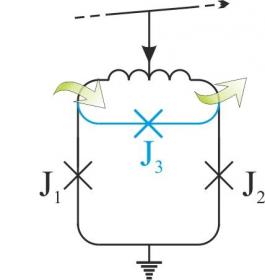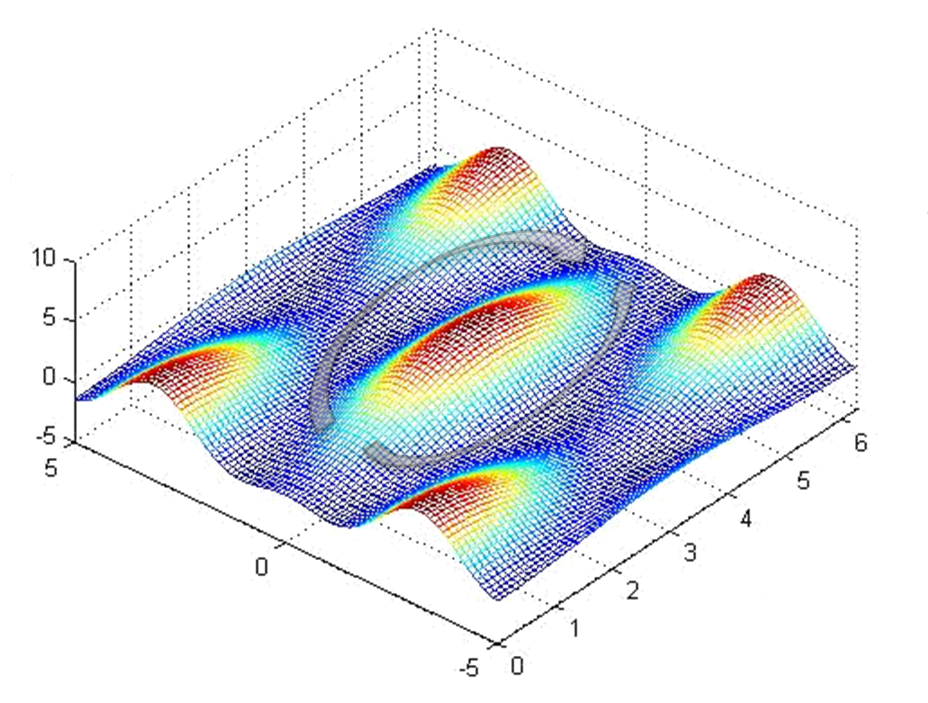
A new superconductive reversible circuit for logical elements of supercomputer biSQUID. J1, J2 – Josephson contacts, J3 (blue) – Josephson contact with ferromagnetic
The scientists of SINP and Physics Department of MSU have developed a new micro-circuit biSQUID from superconducting material with zero electrical resistance for the logical elements of supercomputer. Probably, the discovery will decrease energy consumption of supercomputers up to 6 orders of magnitude!
Previously the scientists have developed a micro-circuit with analogous name for the superconductive high linearity magnetic field detectors and high linearity low-noise amplifiers.
Senior researcher of SINP Igor Sokolov told us: "We have proposed BiSQUID in collaboration with the Professor of the Physics Department Viktor Kornev for the instruments of analogous superconductive electronics. Innovation is that now Josephson contact with ferromagnetic is used and that the circuit is used for the reversible calculations."
The name "biSQUID" is originated from the abbreviation "SQUID" - Superconducting Quantum Interference Device –
which is uniquely sensitive to the magnetic field. Prefix "bi" means consolidation of two SQUIDs in one circuit.
It is known, that high energy consumption of the present-day supercomputers is a complicated problem on the way of their further development. According to the evaluations of the scientists, the further increasing of productivity of the supercomputers with current rate will lead to the need of a personal block of atomic power station for the operation of the supercomputer of the following generation.
"Energy consumption depends on a number of factors, including principles of realization of logical operations and selection of the materials used for micro-circuits production", - Assistant Professor of the Physics Department Nikolay Klenov told us.
The processes carried in all present-day computers (personal and supercomputers) are characterized by irreversibility. It means, that part of information is lost during the calculations, i.e. we can't rebuild the input data basing on the output result. As it was shawon in 1961 by R. Landauer such loss of information is accompanied by energy loss and increasing of the temperature of the computer. Using semiconductors which provide electrical resistance also leads to energy losses and computer's heating during the calculations. For the computer's operation it is necessary not only to compensate the energy losses, but also to cool micro-circuits down to the operation temperature. The natural way to solve this problem is to use reversible logical operation which is carried out without information losses and to develop computer's micro-circuits basing on the superconductors with zero electrical resistance.
Besides, recently the scientists from the USA and Japan have experimentally shown that energy consumption of supercomputer reversible circuits can be over 6 orders of magnitude lower, than energy consumption of semiconductor analogous, while energy consumption of the circuits of the existed digital superconductive electronics is only 3 orders of magnitude lower. But superconductive circuits, which they have studied, were sufficiently cumbersome from the point of present-day nanotechnology, and it discourage manufacturing of a supercomputer on their basis.
In order to solve this problem the scientists of the Laboratory of Nanostructures' Physics of SINP MSU, headed by Mikhail Kupriyanov, in collaboration with their colleagues from the Physics Department of MSU began to develop a new superconductive reversible circuits. Recently they have developed a basic element for supercomputer's memory cell - so-called Josephson contact with ferromagnetic material. This discovery provides possiblity for the development of compact and energy-effective superconductive data store, which is a key element for practical application of the existed digital superconductive technology. But logical operations used in this technology are irreversible and therefore energy-efficiency of the circuits is not high.
In order to reach efficient decreasing of energy consumption the scientists of SINP and Physics Department of MSU suggested a new superconductive reversible circuit for the logical elements of supercomputer. It consists of three Josephson contacts, one of which is a previously suggested contact with ferromagnetic.
"Using of ferromagnetics in superconductive reversible circuits allows significant simplification of their design, decreasing of their size and providing adiabatic character of data processing", - SINP Senior researcher Igor Soloviev told us. - "In order of energy release intensity, the processes carried out in the present-day computers and in our circuit, can be compared with stormy flow of a mountain river at the numerous rapids and with slow, almost hidden flow of a wide, full-flowing river at the flat country."
The scientists still have to verify their discovery experimentally. In case of financing the laboratory tests will be probably carried out this year.

A layout of the steady component of the profile of potential of a new reversible circuit biSQUID with Josephson contact with ferromagnetic. Using of ferromagnetic provides existance of unipotential trajectories of system's evolution during the information's transmission (grey arrows), which minimize energy release.
